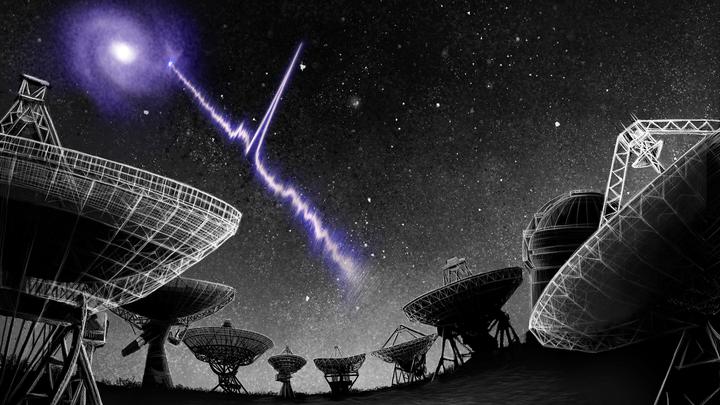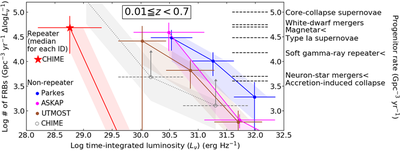 Image credit: [Danielle Futselaar (artsource.nl)]
Image credit: [Danielle Futselaar (artsource.nl)]
Fast radio bursts (FRBs) are mysterious radio signals emerging from extra-galaxies. Observationally there are two different types of FRBs, i.e., repeating and non-repeating FRBs. However, the repetition of the signals does not necessarily mean that these two are physically different populations due to observational limitations of current radio telescopes. New physical parameters to characterize FRBs have been awaited so far.
Here, I report our discovery that these two populations of FRBs show different properties in terms of their (i) brightnesses, (ii) durations, and (iii) luminosity functions (volumetric number density of FRBs as a function of their brightness). Repeating FRBs show relatively longer durations and much fainter luminosities compared to non-repeating ones, with distinct luminosity functions (Figure below). These results indicate that the physical origins of these two types are indeed different. The luminosity functions also allow us to constrain possible progenitors of FRBs. I found that the faint end of the luminosity functions of FRBs are consistent with volumetric number densities of soft gamma-ray repeaters, type Ia supernovae, magnetars, and white-dwarf mergers. This may indicate that faint FRBs originate in any of these progenitor candidates (Figure below).

This project is based on the following publication.
Tetsuya Hashimoto, Tomotsugu Goto, Ting-Wen Wang, Seong Jin Kim, Simon C.-C. Ho, Alvina Y. L. On, Ting-Yi Lu, and Daryl Joe D. Santos, 'Luminosity-duration relations and luminosity functions of repeating and non-repeating fast radio bursts' , accepted for publication in Monthly Notices of the Royal Astronomical Society, (2020).